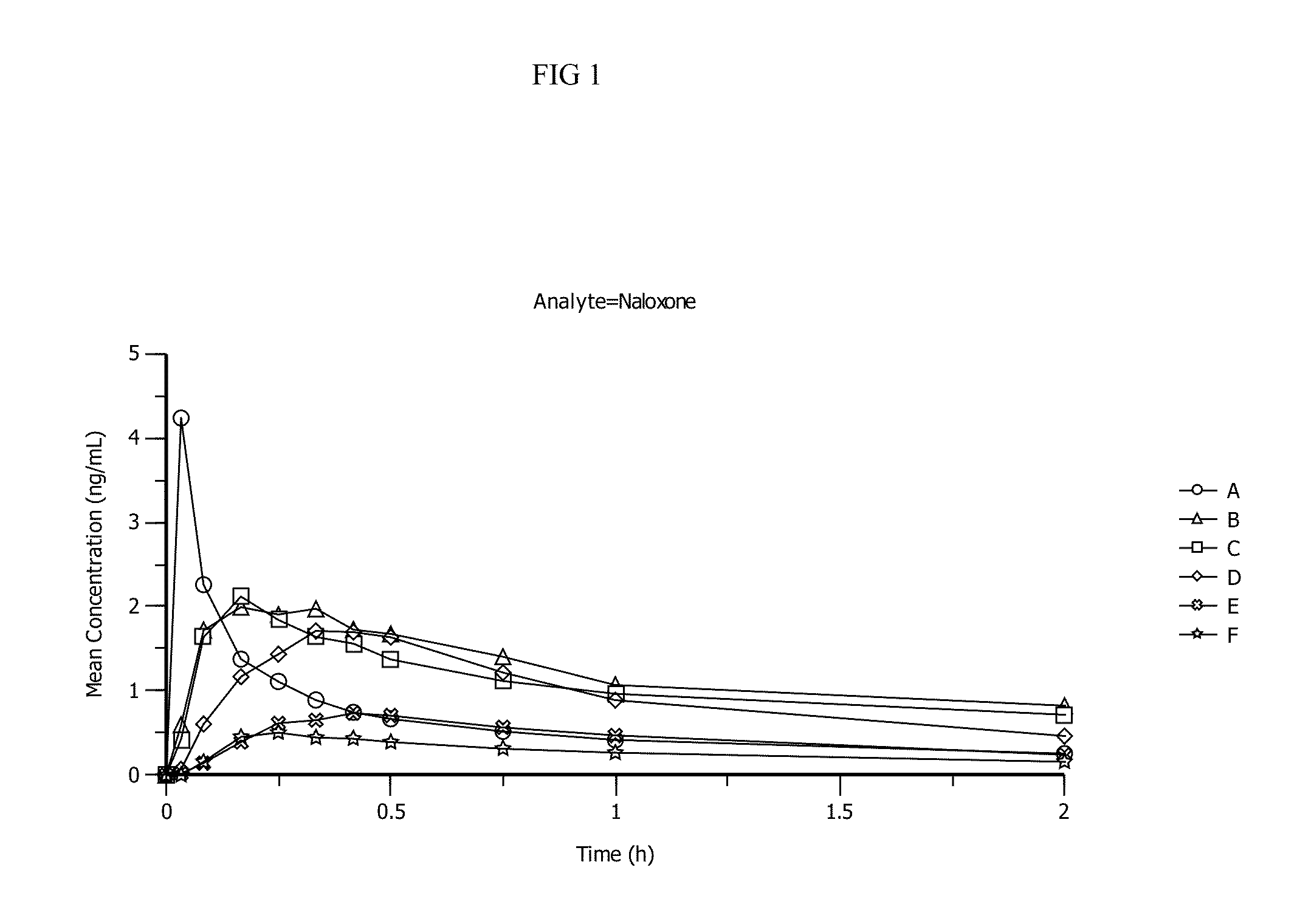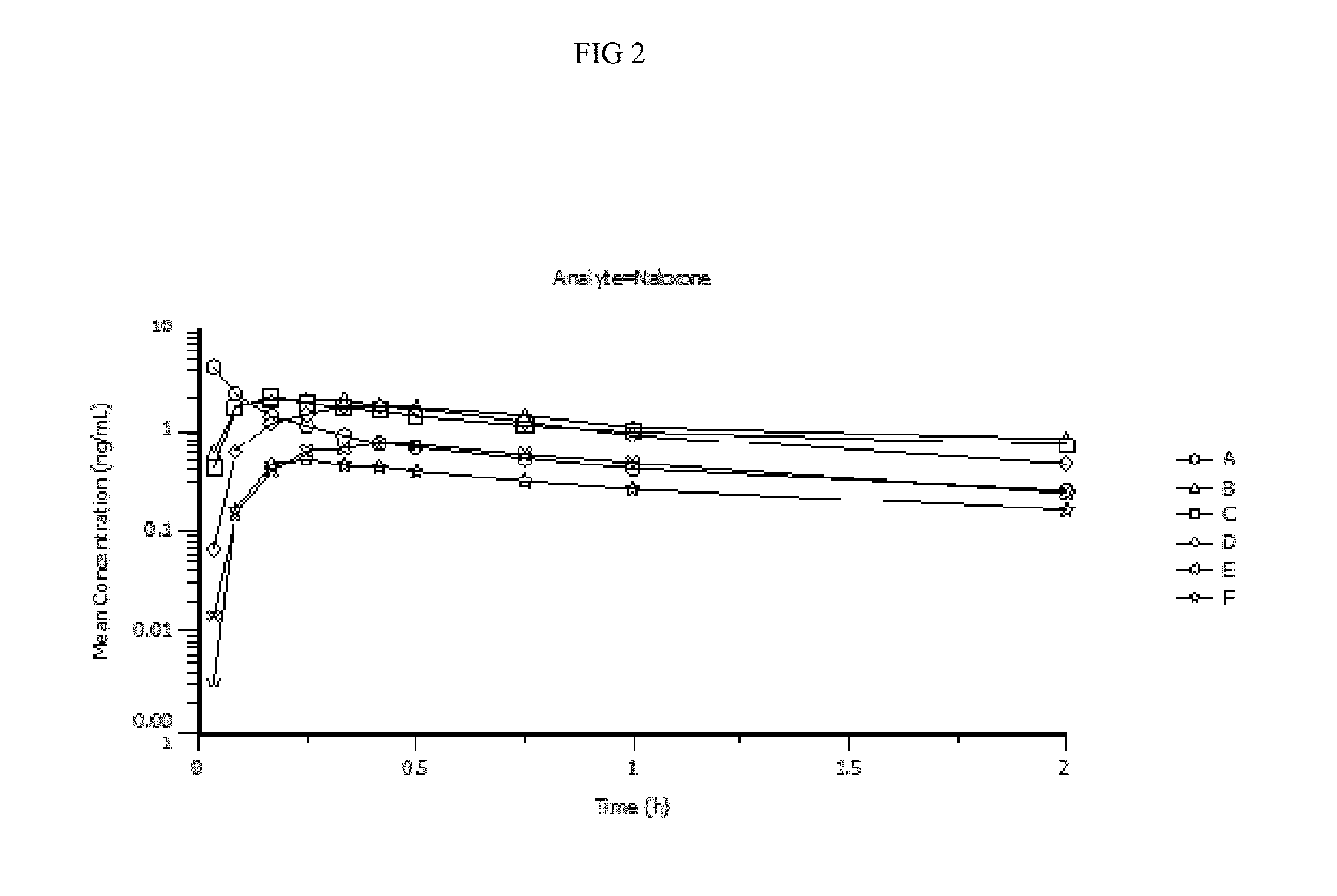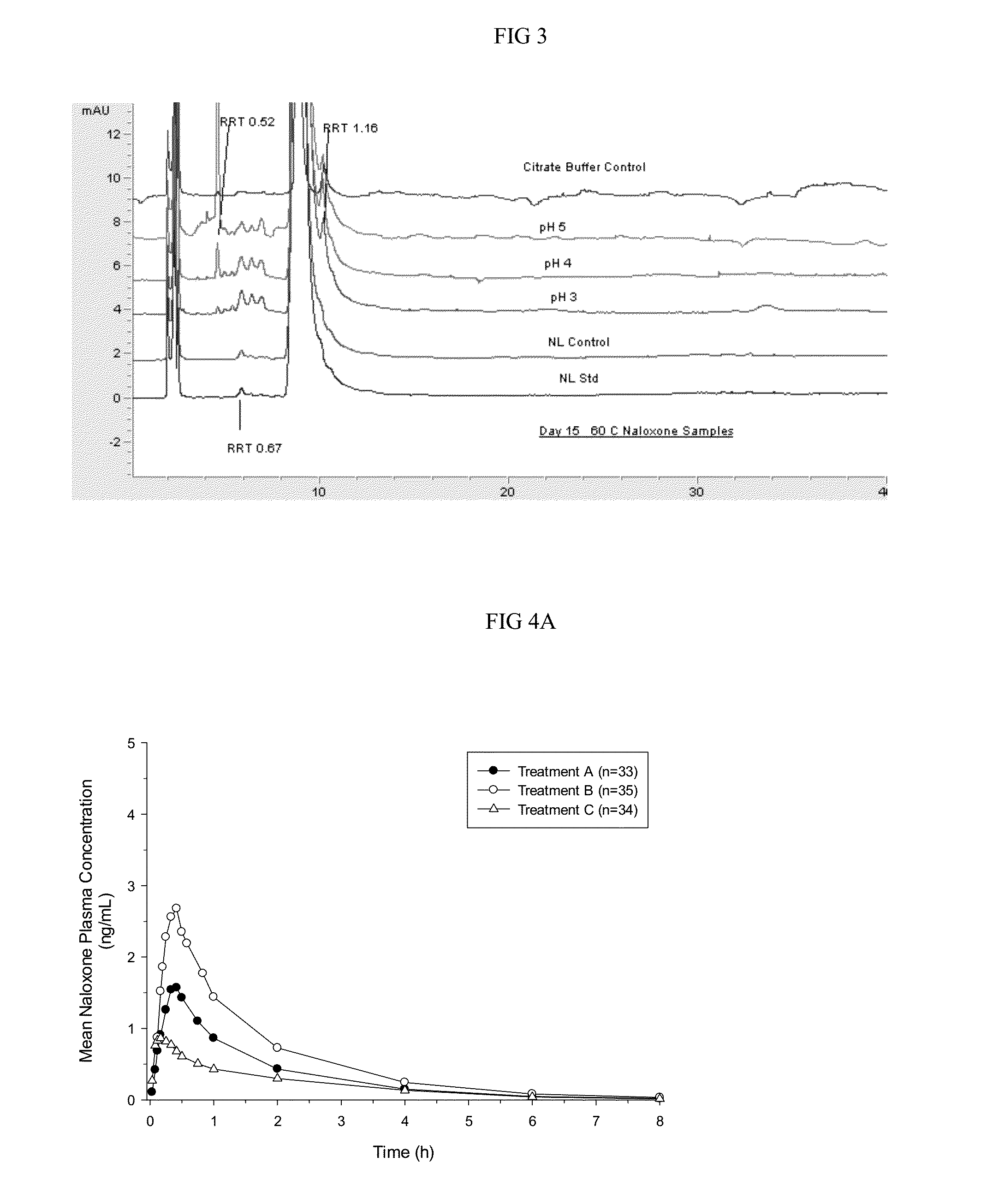Intranasal naloxone compositions and methods of making and using same
a technology of intranasal naloxone and composition, which is applied in the direction of drug composition, nervous disorder, carbohydrate active ingredients, etc., can solve the problems of limiting the use of the drug to a small percentage of the population, the utility of delivering naloxone by lay persons using a needle is not common medical practice, and there are currently no over-the-counter medications used by lay persons
- Summary
- Abstract
- Description
- Claims
- Application Information
AI Technical Summary
Benefits of technology
Problems solved by technology
Method used
Image
Examples
example 1
Exemplary Compositions and Materials
[0084]
TABLE 1Composition of a Single Spray of Naloxone HCl DihydrateNasal Spray, 10 mg / mL (“NNS”)Amount perUnitdoseActuatorQualityComponentCAS #Dose - 100 uLFunctionStandardNaloxone HClN / A1.0 mgActiveUSP, EP,dihydrateBPCitric Acid,77-92-90.48 mg BufferUSP, Ph.anhydrousEur.Disodium6381-92-60.372 mg PreservativeUSP, Ph.EDTAEur.dihydrateBenzyl Alcohol100-51-60.5 mgPreservativeNF, Ph.Eur.Sodium7647-14-5q.s.*AdjustUSPChlorideOsmolalityPurified Water,7732-18-5q.s. toInactive / USPUSP100 uLCarrierHydrochloric7647-01-0q.s. pH topH AdjustmentUSP, Ph.Acid4.25 ± 0.10Eur.Sodium1310-73-2q.s. pH topH AdjustmentUSP, Ph.Hydroxide4.25 ± 0.10Eur.Nitrogen Gas**CompoundingUSP, NFOverlay*Osmolality is adjusted to 385-425 mOsm prior to final q.s. with Purified Water to yield final osmolality within 365-425, an in process specification requirement prior to vial filling.**Nitrogen gas used to purge purified water prior to compounding, as overlay during compounding and as a...
example 2
Methods of Making Exemplary Compositions
[0086]
TABLE 3Exemplary Formulation Method. The following componentsare used to prepare Naloxone HCl Nasal Spray (“NNS”) bulkformulation in a 10 kg scale.QuantityNominal Con-% ofQualityRequired forcentration in10 KgComponentStandard10 Kg Batch10 Kg BatchBatchNaloxoneUSP, Ph100 g 10mg / mL1.00%HCl dihydrateEur, BPCitric Acid,USP, Ph Eur48 g25mM0.48%anhydrousDisodium EDTAUSP, Ph Eur37.2 g 10mM0.37%dihydrateBenzyl AlcoholNF, Ph Eur50 g0.50%0.50%Sodium ChlorideUSPq.s.* Purified WaterUSPq.s. HCl 1N**USP, Ph EurAs neededq.s.**NaOH 1N**USP, Ph EurAs neededq.s.**NitrogenUSP, NFOverlay*Sodium Chloride added as needed to bring Osmolality to 365-425 mOsm**Added as needed to adjust pH to 4.25 ± 0.10 during formulation
[0087]Manufacturing is conducted in a controlled environment using equipment and facilities that are operated in compliance with cGMP. Naloxone HCl can be manufactured at commercial scale using the same process used for clinical at a 10 kg scale...
example 3
Pharmacokinetic Data
[0106]Pharmacokinetic parameters for naloxone administered by using conventional FDA-approved products, routes of delivery and doses were compared to a naloxone nasal spray drug product. In addition, naloxone pharmacokinetic parameters were studied after using an FDA-approved naloxone injection product given by a common, but not approved, route of delivery by a nasal atomizer device. The study arms and doses are outlined below.
[0107]Treatment A:
[0108]0.4 mg Naloxone HCl injection solution administered by intravenous (IV) injection [0.4 mg IV]
[0109]Treatment B:
[0110]1 mg Naloxone HCl injection administered by IM deltoid muscle injection [1 mg IM]
[0111]Treatment C:
[0112]1 mg Naloxone HCl injection administered by SC injection on the arm [1 mg SC]
[0113]Treatment D:
[0114]2 mg NNS using 2 sprays of 1 mg / 100 uL naloxone HCl (1 spray [1 mg / 100 uL] in each nostril) [2 mg NNS, 10 mg / mL]
[0115]Treatment E:
[0116]1 mg NNS solution using 1 spray of 1 mg / 100 uL Naloxone HCl (1 ...
PUM
| Property | Measurement | Unit |
|---|---|---|
| weight % | aaaaa | aaaaa |
| concentration | aaaaa | aaaaa |
| concentration | aaaaa | aaaaa |
Abstract
Description
Claims
Application Information
 Login to View More
Login to View More - R&D
- Intellectual Property
- Life Sciences
- Materials
- Tech Scout
- Unparalleled Data Quality
- Higher Quality Content
- 60% Fewer Hallucinations
Browse by: Latest US Patents, China's latest patents, Technical Efficacy Thesaurus, Application Domain, Technology Topic, Popular Technical Reports.
© 2025 PatSnap. All rights reserved.Legal|Privacy policy|Modern Slavery Act Transparency Statement|Sitemap|About US| Contact US: help@patsnap.com



